Rainbow trout are one of the most popular and easy of all trout to catch. They are found througout North American, including Canada and Mexico, and will take a wide variety of baits and lures. The most popular technique for catching rainbow trout is fly fishing, but they can also be caught using bait casting, spin casting and upstream casting.
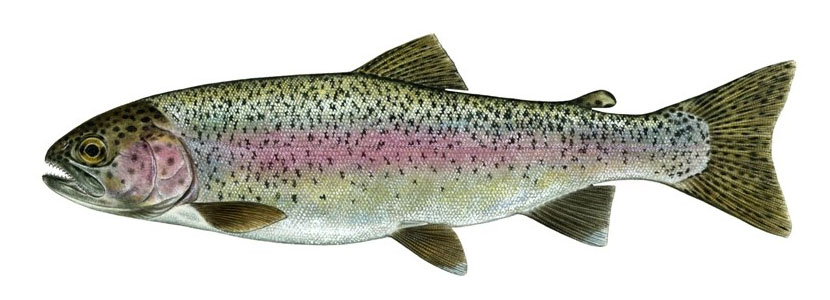
The two main subspecies of rainbows are Golden and Redband Trout, which are found naturally in cold water rivers throughout the Pacific and Midwest states. In fisheries outside of these regions, rainbows are stocked. In certain regions of the United States and British Columbia, specifically the Cascade Mountains and upper Fraser River, respectively, rainbow trout are commonly referred to as redband trout.
- How to Identify Rainbow Trout
- Where to Catch Rainbow Trout
- When to Catch Rainbow Trout
- How to Catch Rainbow Trout
- Best Bait and Lures for Rainbow Trout
- Fishing Tackle for Rainbow Trout
How to Identify Rainbow Trout
Rainbow trout vary in size and coloring. They can be blue, green, silver or yellowish in color. Rainbows usually have white bellies and numerous black spots on their upper bodies, upper fins, and tail. Rainbow trout found in lakes tend to be more silvery in color than their river-dwelling counterparts.
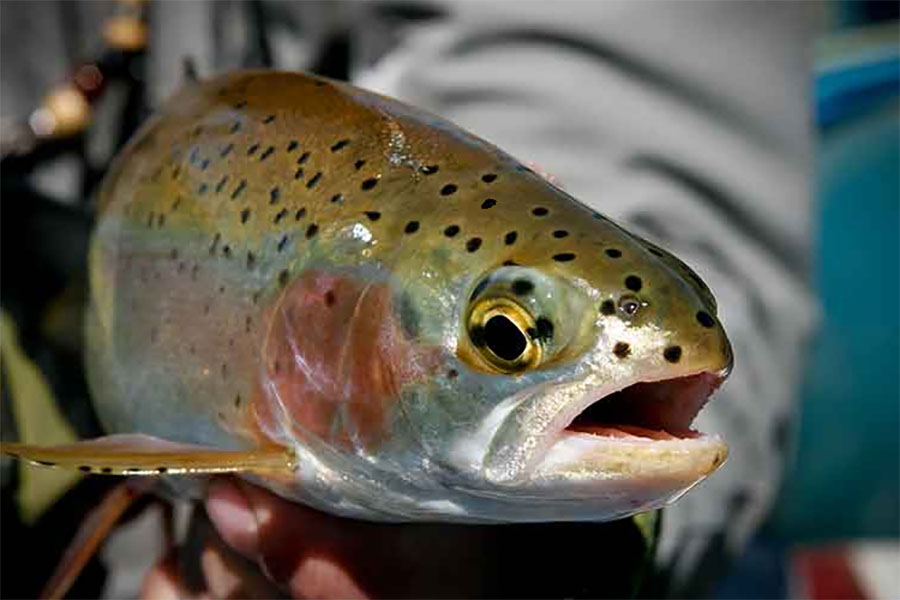
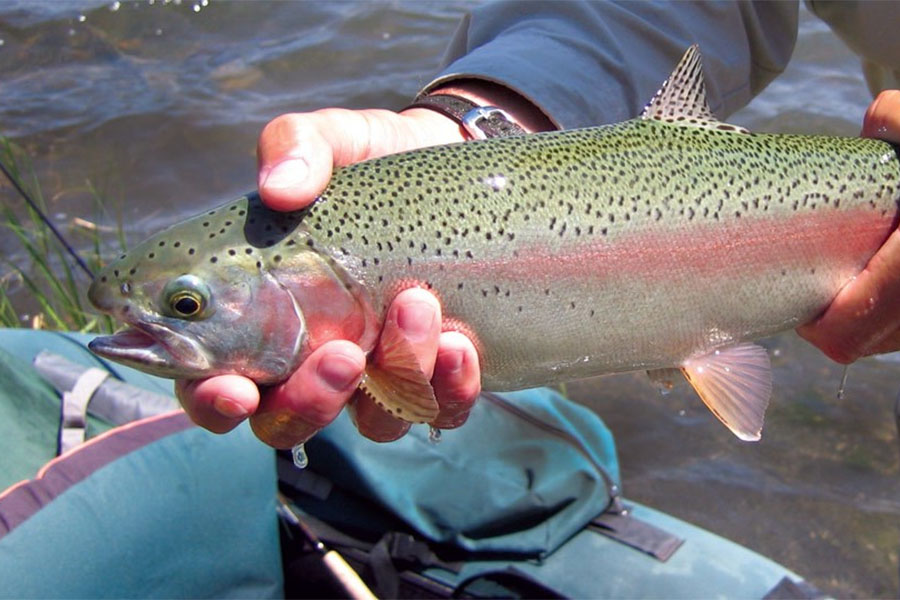

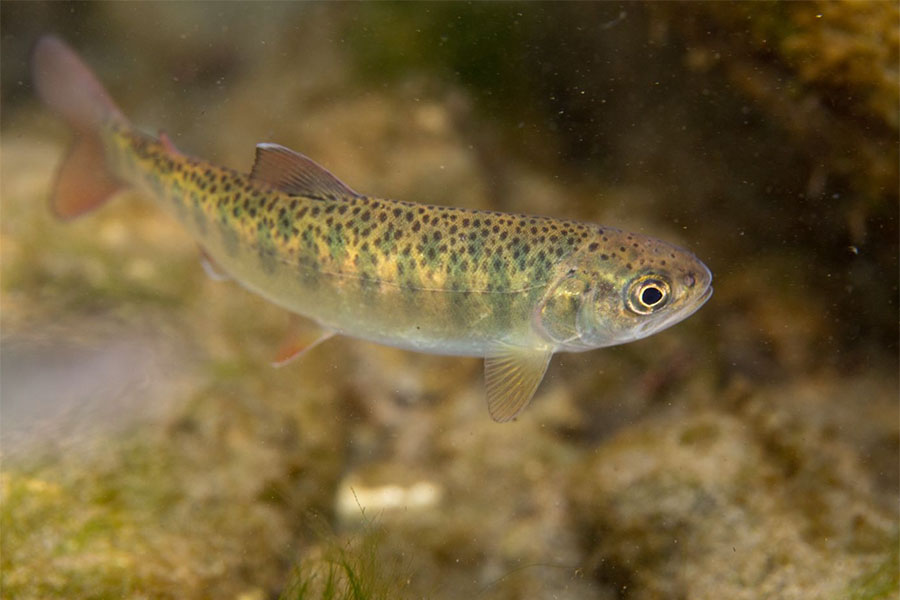
- Size of habitat. Larger streams, rivers and lakes that provide ample space an less competition tend to produce larger rainbow trout.
- Water temperature. Temperatures between 45 and 65°F are ideal for rainbow trout growth and development.
- Availability of food. Habitats that provide an abundance of aquatic and terrestrial insects for food produce larger trout.
- Overall population size. Where large populations of rainbows exist in confined habitats, competition for food and territory tend to keep trout sizes smaller.
- Water quality Clear, cool, well-oxygenated water is ideal for optimal growth and longevity of rainbow trout populations.
- Fishing pressure and predation. High fishing pressure from anglers and natural predation tend to reduce populations of more mature and larger rainbow trout.
Trout size can vary significantly from one habit to the next. Larger rainbow trout in the 5 to 10 pound and 15 to 25 inch range are likely to be found in streams, rivers and lakes with optimial conditions. Rainbows found in poorer conditions are typically smaller.
Where to catch Rainbow Trout
Rainbow trout are found in freshwater streams and rivers throughout North America. They are native to the west coast of southern Alaska, Canada, the continental U.S., and Mexico. Other than their native waters, rainbow trout can be found in fresh waters in southern Canadian provinces as far south as northern Georgia and Alabama, including the Great Lakes and Appalachians. They also inhabit streams and rivers from the southeastern U.S. to western Texas. The largest populations of rainbow trout are found in the northeastern United States. Rainbows are rarely found in the central U.S.
If you want to catch large rainbow trout, I highly recommend taking a trip to Alaska. Several of Alaska’s rivers, including the Naknek and Kvichak River, provide some of the best fishing for trophy rainbow trout. Excellent rainbow trout fishing in Alaska can also be found in the Upper Cook Inlet, Kodiak Island, and Copper River drainage.
Some of my favorite state-side destinations for fishing rainbows include:
- White River (Arkansas)
- Upper Connectict River (Vermont)
- Lower reaches of Fryingpan River (Colorado)
- Deschutes River (Oregon)
- Kern River (home to California’s Kern River Rainbows)
- Strawberry Reservoir (Utah)
There are many more lakes, streams and rivers that offer superb rainbow fishing, but these are a few of my favorite.
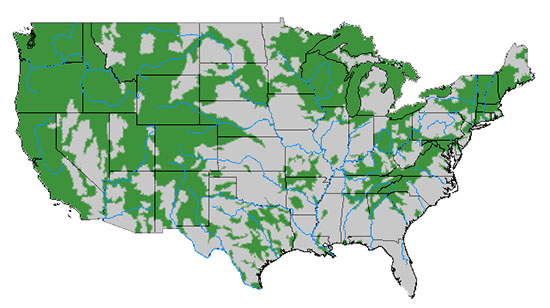
Rainbow trout prefer clean cool freshwater mountain streams, lakes and rivers. The ideal water temperature for rainbows is between 55 and 60 degrees Fahrenheit, but they can survive in water between 32 and 70 degrees Fahrenheit. While they adapt to different environments, rainbow trout are rarely found in water that remains above 70 degrees for an extended period.
Rainbows prefer shaded areas with abundant natural cover and vegetation. They are found in streams and rivers where currents are strong, as well as deep, cool lakes and waterways. Rainbows thrive in water that supports an abundant source of aquatic and terrestrial insects, minnows, and crustaceans.
Fishing for Rainbows in Moving Water
Rainbow trout can be found in most parts of a moving stream or river. However, you’ll catch most rainbows in deep slow-moving pools near natural cover. Rainbows also tend to congregrate above and below dams, riffles, log jams or other natural barriers that slow the flow of water and allow water to pool. Shaded areas along a river bank, and other areas that provide cover are also prime rainbow habitat.
Fallen trees and rocks serve as a current break for trout trying to conserve energy. Cast your line in water pockets that form behind boulders, along current edges where the water slows, outside bends, and near deep undercut banks and you’re sure to find rainbow trout.
When fly fishing in current, it’s best to cast your fly upstream and allow it to float down over any area where fish may be hiding. This technique will greatly improve your catch rate, especially when fly fishing fast moving streams and rivers.
Fishing for Rainbows in Still Water
When fishing for rainbow trout in still water, such as ponds and lakes, the key to finding them is to find cover. Targeting cover, including weedbeds, rock piles, fallen trees, or even under a dock, are your most likely bets for catching rainbows.
Still waters can be fished for rainbows using either fly fishing gear or a traditional casting rod. When fly fishing, you need to land your fly as near as possible to the location of the trout. When bait casting, you’ll want to cast into, or over, the cover where rainbows are found and then pull your bait or lure through the cover.
The following are likely habitats where you can catch Rainbow Trout:
- Current Edges
- Dams and Falls
- Drop-offs
- Outside of Bends
- Overhanging Trees and Bushes
- Riparian Zones
- Rock and Boulder Pockets
- Small Pointed Waves
- Undercut Banks
When to Catch Rainbow Trout
Rainbow trout can be fished year round but some seasons are better than others for fishing wild rainbows. I’ve found that spring and fall tend to be the best times of year for fishing rainbows as this is when water temperatures are ideal (45 to 65 degrees Fahrenheit.) In some areas of their range, rainbow trout fishing is also productive throughout the winter months.
Rainbow trout will feed throughout the day but early morning and late afternoon when sunlight is weakest tend to be the most productive hours of the day for fishing rainbows.
How to catch Rainbow Trout
Rainbow trout are a favorite among fly fishermen. These fish are lively, strong, and enjoyable to catch. Look for them in downstream flows or near shorelines with a lot of gravel. During the summer months, they tend to go to the deeper, cooler waters. The best time to fish for rainbow trout is at dusk or late evening when they feed. Anglers can use various methods and technique to catch rainbows, including drifting an artificial lure, dry fly fishing, hanging a lure below a bobber, or nymphing fly fishing.
The following are the most popular fishing methods and techniques for catching Rainbow Trout:
- Fly Fishing – This is one of the most popular techniques for catching rainbow trout. It can be used for lake fishing but is more common for fishing mountain streams and rivers. If you’re just getting started, the first thing you’ll need is the right equipment. You’ll find a list of recommend gear for fly fishing rainbow trout in the following section.
After you have the right gear, position yourself below the location on the river you want to fish. Cast your fly upstream and allow it to drift through your target fishing spot. Make mends and keep as much of your fly line in the water as possible to allow the fly presentation to look natural.
When fly fishing for rainbows in still water, such as a lake or large pond, I recommend using a dropper rig with a dry fly (indicator/hopper) on the surface and a wet fly (streamer/leech) suspended below the surface about 4 feet, followed by a chironomid fly at the end of the leader line 12 inches below the wet fly. If the water temperature is cold, you may need to adjust the depth of your presentation to reach the rainbows feeding in deeper water. One you get your wet fly at the right depth, give it a wiggle and then let it sit.
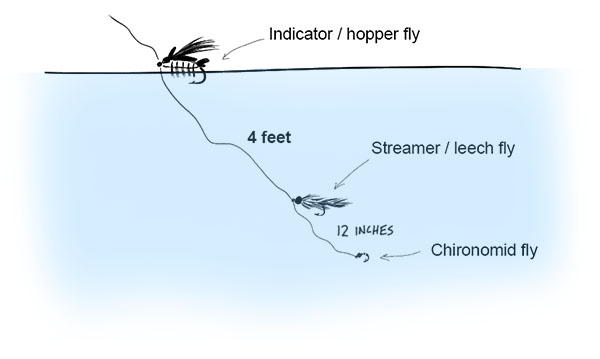
Dropper rig with dry fly and wet fly. - Spincasting (or spinning) – Fishing with a spincasting or spinning reel is an effective method for catching rainbows in moving or still water. There are numerous ways you can catch trout with spinning gear—which entails a spinning reel and rod. Spinning is ideal for light to medium size rainbows.
Spinning rods are great for trout fishing in general because they’re easy for just about any angler to use, compared to baitcasting which requires experience and skill. Another plus is that spinning can be just as effective as fly fishing but the gear is a lot more affordable.
With spinning you can cast artificial lures or bait from the bank or from behind a boat. Spinning gear is also ideal for vertical jigging, trolling, drift fishing or ice fishing for rainbows.
- Bait Casting – Using a baitcaster setup works well when casting from the bank or trolling for rainbows in a lake. They’re a little more challenging to use than spinning rods but you can get a good hookset when the trout takes the bait.
Baitcasters allow you to launch bait from the tip of the rod by releasing the spool with your hand and allowing the bait to take the line as it flies through the air to land at the target fishing spot. Baitcasting is ideal for heavier fishing line and tackle and allows for better placement of bait.
- Upstream Casting – This is a fly fishing technique where you position yourself downstream from your target fishing spot and then cast your fly upstream allowing it to drift through the path of the waiting trout. When the fly reaches downstream from your postion you can then real it in and repeat the technique.
Best Bait and Lures for Rainbow Trout
Rainbow trout are aggressive feeders and will take a large variety of baits, including worms, roe, insects, leeches and egg sacks. When available, crustaceans—such as shrimp and crayfish—are also great rainbow trout bait.
When fishing with aquatic or terrestrial insect bait, always try to match your bait to the trout’s natural food source. Targeting trout using a bait they’re familiar with will increase the likelihood of a bite.
Rainbows will also take a variety of artificial lures. Inline spinners, spoons, plugs and flies are all excellent choices for targeting rainbow trout. Its important when fishing with flies to “match the hatch”. Select fly patterns that match the seasonal fly hatches along the portion of river or stream you’re fishing.
Dry flies, wet flies, nymph flies, emergers and streamers are all great for getting hungry rainbows to take a bite. Some of my favorite dry flies include Parachute Adams, Elk Hair Caddis, and Chernobyl Ant. Emergers I use to reel in trophy rainbows include RS2, Sparkle Pupa and Klinkhammer. Nymph patterns including Pheasant Tail, Prince Nymph, and Gold Ribbed Hare’s Ear are great options as well. Classic streamers including the Wooly Bugger (black or white), Morrish Mouse and Clouser Minnow will also reel in trophy rainbows.
The following chart shows recommended baits and lures for fishing rainbows based on your chosen fishing technique.
| Fishing Technique | Baits/Lures |
|---|---|
| Fly Fishing | Recommended flies:
|
| Spinning | Artificial lures include:
|
| Baitcasting |
|
Fishing Tackle for Rainbow Trout
The fishing tackle and gear required for rainbow trout will depend on the fishing technique you choose. The following is a list of the gear I recommend for each method of rainbow trout fishing.
The following is recommended gear for fly fishing for rainbow trout.
| Fly Fishing Gear | Description |
|---|---|
| 9ft 5 to 6-weight rod and reel combo | A 5 to 6-weight rod is just a bit bigger than what you may need for most trout fishing but the 6-weight will ensure you can cast larger flies when you need to |
| Trout weight-forward floating line | A trout specific line will ensure optimal performance in the cold mountain waters where you're going to find most rainbow trout |
| 7-9ft, 5X nylon knotless tapered leadert | This is a versatile leader line that is strong enough for large rainbows but still light enough to create an attractive presentation with a drag-free drift |
| 4X and 6X nylon tippet | The spool of 4X nylon tippet is for replacing your leader line. The 6X is for sizing down when you want to use smaller flies |
| Fly box with flies | A box flies for catching rainbows. You'll want to use flies that mimic natural prey, but I recommend always having some woolly buggers, parachute Adam's dry flies Elk Hair Caddis, Stimulators (for dry dropper rigs)k Pheasant Tail and Hare's Ear Nymphs |
| Miscellaneous items | Fishing net, waders and wadding boots, fishing vest, tote bag, nippers and hemostats/pliers |
The following is recommended gear for spinning for rainbow trout.
| Spinning Gear | Description |
|---|---|
| 6-7 ft ultralight or medium-weight spinning rod | This spinning rod is ideal for most sizes of rainbow trout when casting, drifting, jigging or trolling artificial lures. When trolling it's ideal to have 2-4 spinning rods rigged with a variety of baits at various depths |
| 20"-30" medium-light to medium spinning rod | This is the ideal size spinning rod for ice fishing rainbow trout using jigging technique |
| Monofilament and/or braided line | 4-15 lb test monofilament line for casting and drift fishing. 4-10 lb test monofilament for ice fishing. For vertical jigging and trolling use 10-20 lb test braided line as it will not stretch. |
| Bait | Minnows, shiners, shad, ciscos, crayfish, freshwater shrimp, nightcrawlers, mealworms, sweet corn, powerbait, wax worms (for lake trolling mimic naturally occurring baitfish) |
| Artificial Lures | Plugs, crankbaits, spinners, and spoons. Small jigs and spinners that mimic natural prey for small streams and ice fishing. Furry jigs, spoons, and jig heads dress with bait (wax worms, minnows) for vertical jigging. Baited jig heads also work well for ice fishing |
| Miscellaneous items | Fishing net, waders and wadding boots, fishing vest, tote bag, nippers and hemostats/pliers |
The following is recommended bait casting gear for fishing rainbow trout.
| Bait Casting Gear | Description |
|---|---|
| 5-6" Medium-weight baitcaster rod | Go with the small rod that fits you. You want to be as minimal as possible when trout fishing. Your baitcaster reel will give you the power required to cast and reel in your catch. Choose a premium cork or EVA foam handle for maximum comfort fishing. I recommend a slow action rod that bends towards the hand. |
| Lightweight baitcaster reel | You'll want a lightweight size 50 baitcaster reel to go with your medium-weight rod. This is one of the smallest baitcaster reel sizes. This reel will weigh about 5 oz, have a line capacity of 12/65 (lb/yd), max drag of 10 lbs, and a retreive rate of 23" to 29" (ipt). However, baitcaster sizes are not standardized and vary by manufacturer. The numbers I provide are only approximations. |
| 10-20lb braided or monofilament line | 10-20 lb braided line is ideal for fishing decent size rainbows, but you can also use a flourocarbon or monofilament line as well. Braided line tends to cast farther, is more sensitive to bites and is stronger. A monofilament line stretches a bit and gives you an extra split second to set the hook in the trout's mouth. |
| 4 foot, 4 lb flourocarbon leader | Flourocarbon leader helps hide the line from the site of the trout. Where a spinning setup requires a swivel to attach the leader to main line, with the baitcaster setup you can tie the leader line directly to the main line using a Surgeon's knot |
| Bait | Baitcasters require a slightly heavier bait or lure than what is required for spinning. I recommend crankbait, spinnerbait, spinners, stickbait, corn, powerbait, rooster tails, worms and mealworms. Lighter lures will work but can result in line tangles |
When selecting terminal tackle for rainbow trout fishing there are couple things you want to remember. First, rainbow trout have great eyesight. If you use a heavy fishing line, you’ll scare off a lot of trout. You want to use the lightest fishing line you can get away with. I typically recommend using a 4-6 pound flourocarbon line.
You also want to use a small hook size. Not only do rainbow have excellent vision, they also have small mouths. The smaller your hook, the more likely a rainbow will take your bait.
Using a light line and small hook will greatly increase your catch rate with rainbows, especially in rivers and lakes where there’s a lot of fishing pressure.



